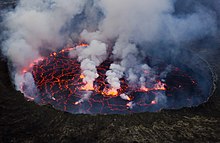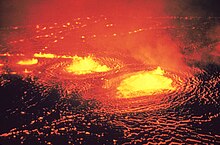Lava lake







Lava lakes are large volumes of molten lava, usually basaltic, contained in a volcanic vent, crater, or broad depression. The term is used to describe both lava lakes that are wholly or partly molten and those that are solidified (sometimes referred to as frozen lava lakes in this case).
Formation
Lava lakes can form in three ways:[1]
- From one or more vents in a crater that erupts enough lava to partially fill the crater
- When lava pours into a crater or broad depression and partially fills the crater
- Atop a new vent that erupts lava continuously for a period of several weeks or more and slowly builds a crater progressively higher than the surrounding ground.
Notable examples
Persistent lava lakes are a rare phenomenon. Only a few volcanoes have hosted persistent or near-persistent lava lakes during recent decades:
- Erta Ale,[2] Ethiopia,
- Mount Erebus,[3] Antarctica (Ross Island),
- Kīlauea,[4] Hawaii (Big Island),
- Mount Nyiragongo,[5] Democratic Republic of the Congo.
Kilauea has the distinction of having two persistent lava lakes: one in the Halemaʻumaʻu vent cavity within the summit caldera, and another located within the Puʻu ʻŌʻō cone located on the east rift zone of the volcano.[6]
Nyiragongo lava lake has usually been the largest one (and the most voluminous) in recent history -the depth/size of lava lakes can vary considerably with time- reaching a size of 700 meters wide in 1982,[7] although Masaya is believed to have hosted an even larger lava lake at the time of the Spanish conquest, being 1000 meters wide in 1670.[8]
In addition to the aforementioned persistent lava lakes, a certain number of occurrences of temporary lava lakes (sometimes called lava ponds or lava pools, depending on their size and nature[9]) have also been observed and are listed in the following table.
List of volcanoes having displayed past or present lava lake activity
| Volcano | Location |
|---|---|
| Persistent or near-persistent lava lakes during recent decades | |
| Erta Ale[2] | Ethiopia |
| Mount Erebus[3] | Antarctica (Ross Island) |
| Kīlauea[4] (two lava lakes in both Halemaʻumaʻu and Pu'u O'o craters) | Hawaii (Big Island) |
| Nyiragongo[5] (the largest one in the past century) | Democratic Republic of the Congo |
| Recent intermittent lava lake activity | |
| Masaya[10] | Nicaragua |
| Ambrym[11] (two lava lakes in both Benbow and Marum craters) | Vanuatu (Ambrym Island) |
| Villarrica[12] | Chile |
| Karthala[13] | Comoros (Grande Comore) |
| Piton de la Fournaise [14][15] (small temporary lava pond in Dolomieu crater) | Réunion Island |
| Ol Doinyo Lengai [16][17] (only occurrence of carbonatite lava pond as it is the only active volcano in the world emitting carbonatite lava) | Tanzania |
| Unconfirmed lava lake activity | |
| Telica[18] (possibly in 1971 and 1999–2000) | Nicaragua |
| Tungurahua[19] (possibly in 1999) | Ecuador |
| Tofua[20] (possibly in 2004 and 2006) | Tonga (Tofua Island) |
| Nabro[21] (possibly in 2012) | Eritrea |
| Lava lake activity suggested by satellite remote-sensing data | |
| Mount Michael[22] | South Sandwich Islands (Saunders Island) |
| Mount Belinda[23] | South Sandwich Islands (Montagu Island) |
| Mawson Peak[24] | Heard Island |
| Past lava lake activity (historical times) | |
| Mount Matavanu[25][26] (during the 1905-1911 eruption) | Samoa (Savai'i Island) |
| Nyamuragira[26][27] (lava lake located within the summit caldera, confirmed for the first time in 1921, drained in 1938, and temporary lava pond in the Kituro cone on the SW flank, during the 1948 eruption) | Democratic Republic of the Congo |
| Capelinhos[28][29] (in 1958, a Surtseyan eruption) | Azores (Faial Island) |
| Surtsey Island[30][31][32] (in 1964, during the 1963-67 eruption which led to the formation of the island) | Iceland |
| Tolbachik,[26][33] part of the Klyuchevskaya volcanic complex (last observation of lava lake activity in 1964) | Russia (Kamchatka) |
| Etna[34] (in 1974) | Italy (Sicily) |
| Ardoukôba[35] (in 1978) | Djibouti |
| Stromboli[36] (in 1986 and 1989) | Italy (Aeolian Islands) |
| La Cumbre[37] (in 1995) | Galapagos (Fernandina Island) |
| Pacaya[38] (in 2000 and 2001) | Guatemala |
See also
References
- ^ http://volcanoes.usgs.gov/images/pglossary/LavaLake.php Lava lake - USGS
- ^ a b http://www.volcano.si.edu/world/volcano.cfm?vnum=0201-08=
- ^ a b http://www.volcano.si.edu/world/volcano.cfm?vnum=1900-02=
- ^ a b "Kīlauea". Global Volcanism Program. Smithsonian Institution.
- ^ a b "Nyiragongo". Global Volcanism Program. Smithsonian Institution.
- ^ http://volcanoes.usgs.gov/hvo/activity/kilaueastatus.php - USGS
- ^ http://www.volcano.si.edu/world/volcano.cfm?vnum=0203-03=&volpage=var
- ^ http://eps.mcgill.ca/~courses/c435/Gravity-papers/rymer%20et%20al%201998.pdf
- ^ Attention: This template ({{cite doi}}) is deprecated. To cite the publication identified by doi:10.1016/0377-0273(94)90015-9, please use {{cite journal}} (if it was published in a bona fide academic journal, otherwise {{cite report}} with
|doi=10.1016/0377-0273(94)90015-9instead. - ^ "Masaya". Global Volcanism Program. Smithsonian Institution.
- ^ "Ambrum". Global Volcanism Program. Smithsonian Institution.
- ^ "Villarrica". Global Volcanism Program. Smithsonian Institution.
- ^ http://www.volcano.si.edu/world/volcano.cfm?vnum=0303-01=&volpage=erupt
- ^ http://www.volcano.si.edu/world/volcano.cfm?vnum=0303-02=&volpage=erupt
- ^ http://terreetvolcans.free.fr/fr/news.php?id1=561&t=10&n=id
- ^ http://www.volcano.si.edu/world/volcano.cfm?vnum=0202-12=&volpage=erupt
- ^ http://www.youtube.com/watch?v=djW31_TkXFI
- ^ http://www.volcano.si.edu/world/volcano.cfm?vnum=1404-04=&volpage=var
- ^ http://www.volcano.si.edu/world/volcano.cfm?vnum=1502-08=&volpage=erupt
- ^ http://www.volcano.si.edu/world/volcano.cfm?vnum=0403-06=&volpage=erupt
- ^ http://www.activolcans.info/eruption-volcanique-du-volcan-Nabro-201204.html
- ^ http://www.volcano.si.edu/world/volcano.cfm?vnum=1900-09=
- ^ First recorded eruption of Mount Belinda volcano (Montagu Island), South Sandwich Islands, Bull Volcanol (2005) 67:415–422 (PDF)
- ^ http://www.volcano.si.edu/world/volcano.cfm?vnum=0304-01=&volpage=var#bgvn_3111
- ^ http://www.volcano.si.edu/world/volcano.cfm?vnum=0404-04=&volpage=erupt
- ^ a b c Tazieff, Haroun, Cratères en feu, éd. Arthaud, 1951.
- ^ http://www.volcano.si.edu/world/volcano.cfm?vnum=0203-02=
- ^ http://www.geocaching.com/seek/cache_details.aspx?guid=dc34c23c-5c0d-470e-a980-5e03a60d40a8
- ^ http://www.vulcaodoscapelinhos.org
- ^ http://www.volcano.si.edu/world/volcano.cfm?vnum=1702-01=&volpage=erupt
- ^ http://stories.inspiredbyiceland.com/story/658001
- ^ Duncan C. Blanchard, From Raindrops to Volcanoes: Adventures With Sea Surface Meteorology, Dover Publications, 1967.
- ^ http://www.volcano.si.edu/world/volcano.cfm?vnum=1000-24=&volpage=erupt
- ^ http://www.volcano.si.edu/world/volcano.cfm?vnum=0101-06=&volpage=var#cslp_7410
- ^ http://www.volcano.si.edu/world/volcano.cfm?vnum=0201-126&volpage=var
- ^ http://www.volcano.si.edu/world/volcano.cfm?vnum=0101-04=&volpage=var
- ^ http://www.volcano.si.edu/world/volcano.cfm?vnum=1503-01=&volpage=var
- ^ http://www.volcano.si.edu/world/volcano.cfm?vnum=1402-11=&volpage=var
![]() This article incorporates public domain material from the Volcano Hazards Program. VHP Photo Glossary: Lava lake. United States Geological Survey.
This article incorporates public domain material from the Volcano Hazards Program. VHP Photo Glossary: Lava lake. United States Geological Survey.
External links
- Lava lake in Nyiragongo Volcano crater. Video on France 24 TV
- Into the mouth of a volcano, video footage of lava lake in Vanuatu's Marum volcano
